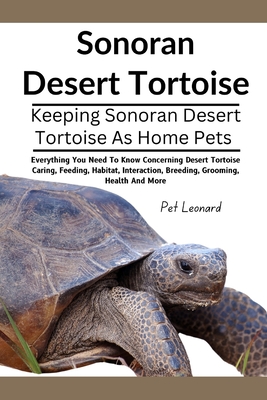Sonoran Desert Tortoise: Everything You Need To Know Concerning Desert Tortoise Caring, Feeding, Habitat, Interaction, Breeding, Grooming, Heal

Sonoran Desert Tortoise: Everything You Need To Know Concerning Desert Tortoise Caring, Feeding, Habitat, Interaction, Breeding, Grooming, Heal
Overview of the Species
The Sonoran Desert tortoise belongs to the family Testudinidae, which includes land-dwelling tortoises. This species was once grouped with the Mojave Desert tortoise (Gopherus agassizii) but was later recognized as a separate species due to genetic and behavioral differences.
Physical Characteristics:
Size: Adults typically measure 9-14 inches in shell length.
Shell: The shell (carapace) is high-domed, dark brown to gray, and slightly ridged, providing camouflage in rocky desert terrain.
Limb Structure: They have stout, elephantine legs adapted for digging and moving over rugged landscapes.
Lifespan: In captivity, these tortoises can live 50-80 years with proper care, making them a long-term commitment for pet owners.
Unique Adaptations:
Burrowing: The tortoise's burrowing behavior helps it survive extreme desert temperatures by escaping the heat of the day and retaining moisture.
Water Storage: They can store water in their bladder for long periods, a vital adaptation for survival in arid conditions.
Natural Habitat and Behavior
Natural Range and Habitat:
The Sonoran Desert tortoise is native to the Sonoran Desert, which spans parts of southern Arizona, southeastern California, and northwestern Mexico, including the Baja Peninsula. Within this range, these tortoises inhabit rocky foothills, desert scrub, and canyon slopes, where they find shelter in crevices and self-dug burrows.
Climate: They thrive in regions with high summer temperatures and low annual rainfall, tolerating extreme heat and cold.
Shelters: Their burrows and rock crevices provide insulation against temperature extremes and protection from predators.
Diet in the Wild:
As herbivores, Sonoran Desert tortoises consume a diet of native grasses, cacti, wildflowers, and other vegetation. Their diet changes with seasonal availability, demonstrating their adaptability to their environment.
Behavioral Traits:
Activity Patterns:
The tortoises are most active during the cooler parts of the day-e
PRP: 108.34 Lei
Acesta este Prețul Recomandat de Producător. Prețul de vânzare al produsului este afișat mai jos.
97.51Lei
97.51Lei
108.34 LeiIndisponibil
Descrierea produsului
Overview of the Species
The Sonoran Desert tortoise belongs to the family Testudinidae, which includes land-dwelling tortoises. This species was once grouped with the Mojave Desert tortoise (Gopherus agassizii) but was later recognized as a separate species due to genetic and behavioral differences.
Physical Characteristics:
Size: Adults typically measure 9-14 inches in shell length.
Shell: The shell (carapace) is high-domed, dark brown to gray, and slightly ridged, providing camouflage in rocky desert terrain.
Limb Structure: They have stout, elephantine legs adapted for digging and moving over rugged landscapes.
Lifespan: In captivity, these tortoises can live 50-80 years with proper care, making them a long-term commitment for pet owners.
Unique Adaptations:
Burrowing: The tortoise's burrowing behavior helps it survive extreme desert temperatures by escaping the heat of the day and retaining moisture.
Water Storage: They can store water in their bladder for long periods, a vital adaptation for survival in arid conditions.
Natural Habitat and Behavior
Natural Range and Habitat:
The Sonoran Desert tortoise is native to the Sonoran Desert, which spans parts of southern Arizona, southeastern California, and northwestern Mexico, including the Baja Peninsula. Within this range, these tortoises inhabit rocky foothills, desert scrub, and canyon slopes, where they find shelter in crevices and self-dug burrows.
Climate: They thrive in regions with high summer temperatures and low annual rainfall, tolerating extreme heat and cold.
Shelters: Their burrows and rock crevices provide insulation against temperature extremes and protection from predators.
Diet in the Wild:
As herbivores, Sonoran Desert tortoises consume a diet of native grasses, cacti, wildflowers, and other vegetation. Their diet changes with seasonal availability, demonstrating their adaptability to their environment.
Behavioral Traits:
Activity Patterns:
The tortoises are most active during the cooler parts of the day-e
Detaliile produsului










